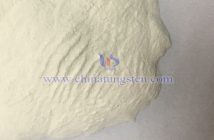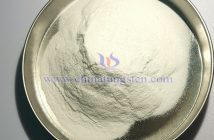The pH of the solution plays a critical role in the formation and stability of the crystal structure of Ammonium Metatungstate (AMT) produced by CTIA GROUP LTD. The crystal structure of AMT is centered around the Keggin-type polyacid anion [H?W??O??]??, and the pH directly influences the polymerization behavior of tungstate ions, which in turn affects the formation, chemical composition, and morphology of the crystals.

Picture of CTIA GROUP LTD ammonium metatungstate
1. pH and Tungstate Polymerization Behavior
The crystal structure of AMT relies on the polymerization of tungstate ions in the solution, a process highly dependent on the solution’s acidity or alkalinity. Different pH conditions lead to the formation of distinct polytungstate species, determining the final crystal structure:
? Neutral to Alkaline Environment (pH > 5):
At higher pH value, tungstate ions primarily exist as monomers or simple polytungstates. These structures struggle to combine with ammonium ions to form stable AMT crystals, often resulting in insoluble tungstate precipitates or amorphous products with irregular crystal structures.
? Weakly Acidic Environment (pH 2-4):
This is the optimal pH range for preparing AMT. In this condition, tungstate ions undergo protonation reactions to polymerize into the Keggin-type polyacid anion [H?W??O??]??, consisting of 12 WO? octahedra surrounding a central oxygen atom. This highly stable structure combines with NH?? ions to form well-defined AMT crystals with clear lattice parameters and high crystallinity.
? Strongly Acidic Environment (pH < 2):
Excessively low pH leads to over-protonation or decomposition of the Keggin structure, forming other polytungstates or amorphous products. These products may have different crystal structures or lack crystallinity, reducing the purity of AMT crystals or preventing the formation of the target structure altogether.
[caption id="attachment_39781" align="alignnone" width="710"] Picture of CTIA GROUP LTD ammonium metatungstate[/caption]
Picture of CTIA GROUP LTD ammonium metatungstate[/caption]
2. pH and Crystal Morphology
The pH not only influences the chemical composition of the crystal structure but also affects the morphology and particle size of AMT crystals. Within the optimal pH range of 2-4, the formation rate of Keggin-type polyacid anions is moderate, allowing balanced nucleation and growth processes. This results in uniform, well-defined crystal shapes, such as cubic or needle-like crystals, with consistent particle sizes.
? Higher pH (>5):
Precipitates formed in this range are often amorphous or microcrystalline, exhibiting irregular particle morphology and numerous crystal defects.
? Lower pH (<2):
Excessively rapid protonation reactions accelerate nucleation, leading to overly small or agglomerated crystal particles with uneven morphology. The crystal lattice may also incorporate non-target structures, compromising uniformity.
3. pH and Crystal Stability
The pH also impacts the chemical and physical stability of AMT crystals. Crystals formed at the optimal pH range (2-4) exhibit a complete Keggin structure with stable coordination between NH?? and [H?W??O??]??, resulting in high thermal stability and solubility (>3,000 g/L at 25°C). If the pH is inappropriate, the resulting crystals may contain unstable polytungstates or impurities, making them prone to decomposition during drying, storage, or application, thus diminishing their specific properties, such as catalytic activity or material performance.



